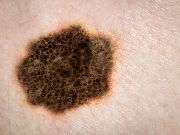(HealthDay)—Squamous cell carcinoma (SCC) can develop on long-standing verrucous lesions, according to a report published as a letter to the editor in the October issue of The Journal of Dermatology.
Shuji Suzuki, from Tottori University in Japan, and colleagues described the case of a 64-year-old woman with a nodule on her left heel for 20 years. She visited the hospital seven years before presentation with enlargement of the nodule; hyperkeratosis, acanthosis, papillomatosis, and hypergranulosis were identified on histological examination, consistent with verruca plantaris. Two months before presentation, the nodule started to grow on the weight-bearing area, with a bad smell.
The team identified a nodule with dry necrosis and ulceration. A yellowish-white granular structure surrounded by reddish reticular structures was seen on dermoscopy. Biopsied histopathology was consistent with SCC; the epidermis had been replaced with exophytic growth of atypical keratinocytes with marked surface keratinization, cancer pearls, necrotic foci, and frequent mitoses. These findings were compatible with verrucous carcinoma type SCC. The MIB-1 index was increased to 25.2 percent; immunostaining against human papillomavirus was negative. Verrucous lesions were seen adjacent to SCC.
"This is the first case of a long-standing verrucous lesion ascertained histopathologically with subsequent development of SCC," the authors write. "Frequent biopsies or excision of a non-surgical treatment-resistant verrucous lesion is necessary, particularly in patients with an immunosuppressive status or with mechanical stimulation."
More information:
Abstract
Full Text (subscription or payment may be required)
Copyright © 2015 HealthDay. All rights reserved.






















